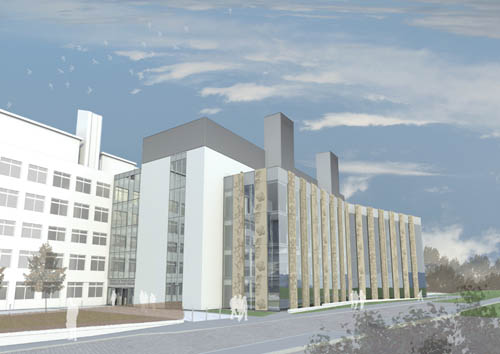THE INTERNATIONALLY renowned research base at the College of Life Sciences at the University of Dundee is to be further expanded with a new £12.5 million Centre for Translational and Interdisciplinary Research.
Work on the new Centre started yesterday. It will enhance Life Sciences capacity, including in drug discovery – an area in which Dundee is already the leading University in the UK and one of the foremost academia-based centres in the world.
Around 200 new research jobs in Life Sciences will be added once the CTIR is complete, adding to the 1000-plus scientists, research students and support staff from 62 countries in already working in the College of Life Sciences in Dundee. Construction work is scheduled to finish in autumn 2013.

“This is another major expansion for the College of Life Sciences that will significantly enhance our capabilities across key areas of research,” said Professor Michael Ferguson, Dean of Research in the College of Life Sciences.
“The high-level objectives are to enhance translational research by expanding drug discovery capacity, to enhance computational biology, mathematical biology and biophysics, and to provide future expansion space.
“We already have very strong drug discovery programmes in the area of neglected tropical diseases – including African trypanosomiasis (sleeping sickness), Leishmaniasis, Chagas’ Disease, tuberculosis and malaria – which are producing strong candidates for drug development. We expect to see these leading to effective drugs for at least one of these diseases.
“We are also addressing other unmet medical needs. What we aim to do is translate our basic research in areas like cancer and eczema, and other diseases, to produce chemical agents that can tackle these problems in an innovative way.
“Universities are very good at innovation. What they haven’t been quite so good at is developing the capability to translate that innovation into new medicines and applications. This new Centre will help us provide that bridging point.”
The CTIR will also bring experimentalists into juxtaposition with mathematical, biophysical and computational biology, breaking down the barriers between the scientific disciplines to facilitate innovative translation of biological and drug discovery research into new therapeutics.
The ground floor will house a brand new High Throughput robotics and molecular pharmacology facility to augment the existing Drug Discovery Unit and to translate basic science into commercial and therapeutic opportunities. The second floor will house Mathematical Biology and Biophysics, Bioinformatics, Data Analysis and Software Development.
Opportunity
The project provides an exciting opportunity to bring these disciplines together, allowing contributions of scientists from a number of different fields, each bringing their expertise to bear on aspects of the larger, systems-level problems relating to biology and drug discovery and drug design.
The construction of the CTIR will cost about £12.5 million. A peer-reviewed Wellcome-Wolfson Capital Award in Biomedical Science of £4.875 million has already been made towards the project. In addition, a contribution of £5 million has been committed by the University of Dundee.
The remainder has been raised thanks to the generous donations of local funding agencies and charitable trusts.
The Biotechnology and Biological Sciences Research Council (BBSRC) has also made a contribution towards a networking centre in the CTIR, thanks to the BBSRC Excellence with Impact Award won by the College of Life Sciences last year.
The front facade of the building will feature large anodised aluminium cladding panels incorporating artistic abstractions representative of 4 key scales of Life Science Research: Molecular, Organellar, Cellular and Tissue. The scientific images will be translated into artwork, to be perforated onto the panels, by Professor Elaine Shemilt and her team from Duncan of Jordanstone College of Art and Design. In addition, the new Centre will contain a gallery for art-science projects.
Professor Ferguson said: “I am particularly pleased to be working with colleagues in our College of Art and Design. As well as bringing together scientific disciplines, the CTIR will also help bridge art and science disciplines – that has to be a good thing.”